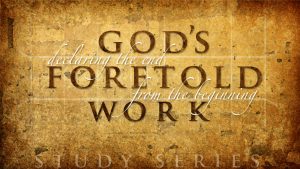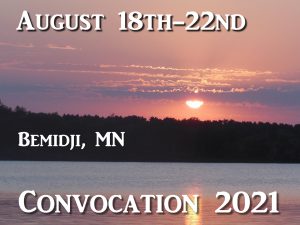Someone recently gave me a commentary on Daniel by Arno Gaebelein written in 1909. After reading his comments on the 70th week, and then Daniel 11, it was easy to see that he could be classified as a Dispensational, Pre-trib, Premillennialist. But, I know that he had a heart for the Jewish immigrants that were pouring into to New York at that time, and even ministered the gospel to them. So how would you reconcile his position?
Gaebelein was old school dispensational pre-trib. All I can say is that his view of Israel’s future, as based on a plain man’s plain reading of the ordinary sense of the prophecies (his hermeneutic) stood him well in seeing the centrality of Israel in the events of the end. But like so many since, the baby got mixed in with the bathwater of dispensationalism, with its view of the interim between 69th and 70th weeks as belonging to a completely UNFORETOLD mystery program that dispensationalists equate with the so-called “church age” that assumes the church begins at Pentecost and ends its sojourn on earth at the pre-tribulational rapture.
In order to maintain the present “age of the church” (a colossal misnomer in my view), dispensationalists argue that consistency demands that this age is the time of the mystery (as they see and define the mystery) that ends with the removal of the church from earth to heaven at the pre-tribulation rapture. Thus, the church, as they define the church, occupies the gap that they recognize between the 69 and 70th weeks of Dan 9:24-27. This provides that the ‘blessed hope’ of the church can be an imminent hope, with the ever present ‘potential’ that Jesus ‘could’ come at any moment. This why, in order for Christ’s return to be maintained as an ever imminent possibility, all the foretold signs that might interpose some necessary event between the believer and Christ’s return for His church, must be seen as taking place only on the other side of the rapture. There can be no outstanding event within this so-called age of the church that can stand between the believer and the ever imminent possibility that Christ might appear any moment.
Of course, this postulate raises so many questions, not least of which is how could the events that begin the 7 years have been possible during the many centuries of Jewish absence from the Land? Not only so, but far more than the 70 years of a single generation, Isaiah predicted that the Land would pass into “many generations” of desolation (Isa 61:4), and this fits with no other time in Israel’s history until the age long dispersion that began with the Roman destruction.
The time after the rapture, in its entirety, is held to be the Day of the Lord, thus, a continual day of wrath to which believers (of this age) are not appointed. This is a recent correction (innovation) to preserve the concept of imminence. In agreement with our view, Gaebelein put the DOL at the end of the tribulation, but since later post-tribulationists (such as Alexander Reese) would point out that believers of this age are instructed to look for, or hasten towards the DOL (e.g., 1Thes 5:2-6; 2Pet 3:10-12), it became obvious that a DOL that does not come till the end of the tribulation can hardly be looked for by believers waiting for a pre-tribulation rapture. The answer was to ‘expand’ the DOL to include the entirety of the 70th week, so that the DOL could start immediately with the pre-tribulation rapture.
In this way, believers could now look for the sudden, thief-like coming of the DOL, because it is seen to begin immediately with the Lord’s pre-tribulational return to catch up the church. In this way, the entire 7 years is made the DOL. Since believers are not appointed to wrath (1Thes 5:9), it is supposed that they cannot be thought to enter any part of the 7 years, which dispensational presuppositions make a seven year long ‘day of wrath’. The problem here is the clear evidence of scripture that saints in the tribulation are NOT under divine wrath. Divine wrath is only visited upon the wicked, but tribulation believers are not exempt from the wrath of man. So this argument fails since a believer’s presence in the tribulation does not imply exposure to divine wrath, demanding pre-trib rapture to escape. Are believers of the tribulation any more appointed to wrath than believers of this age? The answer is self evident, as also the contradiction of appealing to 1Thes 5:9 as support for exemption from tribulation.
Since Reese’s arguments, dispensationalists moved the DOL back seven years to begin with the rapture. This seemed to permit them to see the rapture as an imminent event. However, another, more modern post-tribulational writer, Robert Gundry, in his book, “The Church and the Great Tribulation, pointed out that Paul puts the revelation of the man of sin BEFORE the DOL (2Thes 2:2-3). How could the DOL be held as imminent if “THAT DAY shall come UNTIL the man of sin be revealed FIRST? This is, of course, an outstanding sign that precedes the DOL, precluding the notion that the DOL can happen suddenly, as a thief, with no predicted event preceding, as essential to the idea of imminency. This posed a real problem that was discussed intensely among the defenders of the pre-trib position, but the discussion remained mostly in scholarly journals behind seminary doors.
The proposed solution was to once more adjust the time of the DOL to permit another gap of some unknown duration (probably very brief) in order to permit time for the Antichrist to be revealed AFTER the rapture, yet before the start of the DOL. So twice the DOL has been moved in reaction to errors pointed out in the system. This is well documented.
It should also be mentioned that old school dispensationalists such as C.I.Scofield and Arno Gaebelein, understood the OT righteous to go up in the rapture. But after the arguments of Reese in his book, “The Approaching Advent of Christ,” the resurrection of OT believers was moved forward to the end of the week (‘the last day’). This would mean that Job, Isaiah, Daniel, and all the righteous dead of the OT would remain sleeping in the dust of the earth (Dan 12:1-2) for an additional 7 years after the church has been taken away to heaven. In that sense, they too are ‘left behind’. 🙂
All’s to say, dispensationalism stands or falls with the following two principal pillars: 1.) The doctrine of imminency (in the sense that Christ may appear for His church any moment since the earliest days of the church, particularly since Paul’s revelation of the secret rapture), and 2.) the doctrine of the church (ecclesiology), which assumes that the body of Christ did not exist until the Spirit came to indwell believers at Pentecost, supposing that He was only ‘with’ believers before this time and not ‘in’ them.
This is why dispensationalists interpret the restrainer of 2Thes 2:7 to be the Holy Spirit who must be removed before the man of sin can be revealed. However, they are instant to point out that this is not, of course, the Spirit’s removal from the earth, but only in the sense of His indwelling of believers of this age. Many leading dispensationalists, such as John F. Walvoord, defend this view by arguing for what he calls, “a reversal of Pentecost.” By this, he means that believers that come to faith after the rapture will be born again, of course, but that they will NOT be uniquely indwelt by the Holy Spirit, which dispensationalists believe is unique only to believers of this mystery age of the church.
To answer the many non-sequiturs of Dispensationalism is not something I can enter into now, but for many reasons that could be put forth, the whole edifice falls under its own weight. Any system that must make so many changes in reaction to admitted errors should be profoundly suspect. Yet, it is the leading view among most evangelicals that hold a favorable view of Israel’s place and purpose in the end times. Part of the reason is that most embracing the pre-trib rapture have been told only part of the story. They are not intimately familiar with its history and the principal pillars on which the system stands or falls. Many would blush if they only knew what their scholarly teachers understand to be essential to its defense.
How, particularly now, after the Spirit promised in Joel has been poured out on all who believe, now that Christ has been once and for all glorified (Jn 7:39), can it be imagined that there will be a retraction of Pentecost, so that those that come to faith in the tribulation or in the millennium to follow, are NOT reckoned as members of His body, are NOT baptized by one Spirit into the one Body? When the penitent survivors of Israel look upon Him whom they pierced and receive the Spirit (Zech 12:10), the very same Spirit promised by Joel that was poured out at Pentecost, will they be any less the body of Christ than the penitents of Pentecost? Will they be any less baptized by the promised Holy Spirit into the one Body that believers are baptized into now?
Dispensationalists say they will not. They hold that all who come to faith after the rapture belong to another people of God, with different promises and a different hope. So you can see that much more is at stake than simply where the rapture is placed. The very nature of what constitutes the body of Christ is put in question.
Not only does faith in a pre-trib rapture disarm the church for what it should be prepared to expect, but it robs God of the glory He has invested in the what He intends for the church’s role as prophetic witness to Israel and the nations, full of power, instructing many, and turning many to righteousness (Dan 11:32-33; 12:3; Rev 7:9, 13-14). But this assignment is NOT delegated to the 144,000 Jewish witnesses, unless they also belong to the “church of the living God, the pillar and ground of truth” (1Tim 3:15). Such a notion betrays a woeful ignorance of the nature and calling of the church. It makes the church merely a ‘speed bump’ (a parenthesis) on the way to a glorious millennium that is without the church on earth. How will the pillar and ground of truth be absent from the earth if the persecuted saints of the tribulation are not the body of Christ? It begs the question, what then is the body of Christ? How long shall it endure on the earth?
The whole conception of the nature of the mystery, as “fully foretold”, yet hidden within the prophetic writings (Acts 26:22; Ro 16:25-26; 1Pet 1:11), and the nature of the assembly of Messiah, as the revelation of His body, has been profoundly exchanged for something foreign and unheard of till the mid to late 19th century. As a dearest friend once exclaimed, “they’ve changed the story!”




